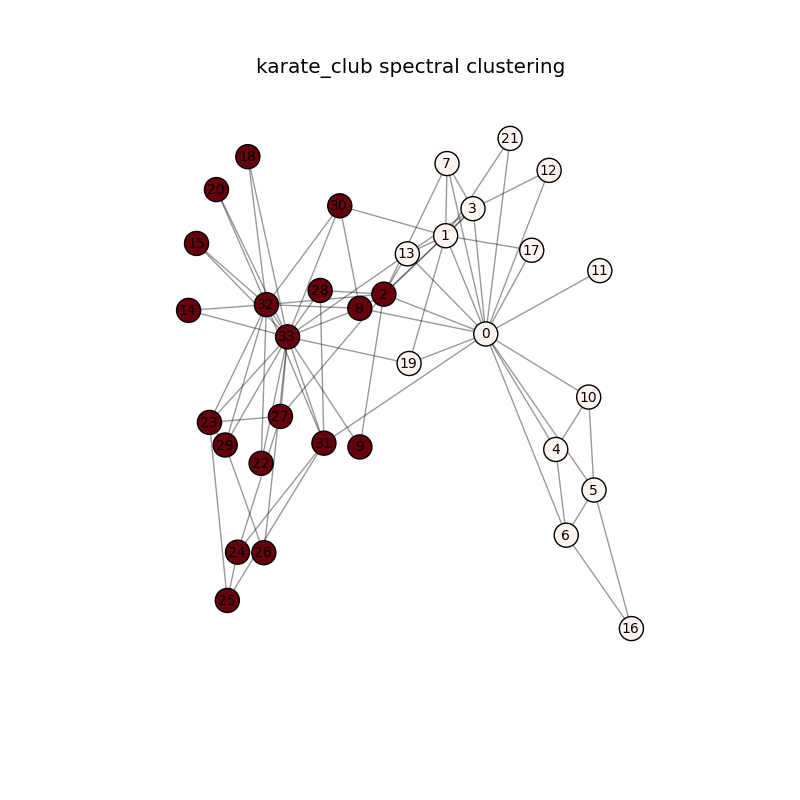轉:完整的最簡單的譜聚類python代碼
阿新 • • 發佈:2018-07-19
得到 for details -c 簡單的 enum off ads odin
http://blog.csdn.net/waleking/article/details/7584084
針對karate_club數據集,做了譜聚類。由於是2-way clustering,比較簡單,得到了圖的新的表示空間之後,沒有做k-means,僅僅針對正規化後的拉普拉斯矩陣的第二特征值做了符號判斷,這和Spectral Clustering Tutorial 一文中的描述一致。
引用了numpy scipy matplotlib networkx包
- #coding=utf-8
- #MSC means Multiple Spectral Clustering
-
import numpy as np
- import scipy as sp
- import scipy.linalg as linalg
- import networkx as nx
- import matplotlib.pyplot as plt
- def getNormLaplacian(W):
- """input matrix W=(w_ij)
- "compute D=diag(d1,...dn)
- "and L=D-W
- "and Lbar=D^(-1/2)LD^(-1/2)
- "return Lbar
- """
- d=[np.sum(row) for row in W]
- D=np.diag(d)
- L=D-W
- #Dn=D^(-1/2)
- Dn=np.power(np.linalg.matrix_power(D,-1),0.5)
- Lbar=np.dot(np.dot(Dn,L),Dn)
- return Lbar
- def getKSmallestEigVec(Lbar,k):
- """input
- "matrix Lbar and k
- "return
-
"k smallest eigen values and their corresponding eigen vectors
- """
- eigval,eigvec=linalg.eig(Lbar)
- dim=len(eigval)
- #查找前k小的eigval
- dictEigval=dict(zip(eigval,range(0,dim)))
- kEig=np.sort(eigval)[0:k]
- ix=[dictEigval[k] for k in kEig]
- return eigval[ix],eigvec[:,ix]
- def checkResult(Lbar,eigvec,eigval,k):
- """
- "input
- "matrix Lbar and k eig values and k eig vectors
- "print norm(Lbar*eigvec[:,i]-lamda[i]*eigvec[:,i])
- """
- check=[np.dot(Lbar,eigvec[:,i])-eigval[i]*eigvec[:,i] for i in range(0,k)]
- length=[np.linalg.norm(e) for e in check]/np.spacing(1)
- print("Lbar*v-lamda*v are %s*%s" % (length,np.spacing(1)))
- g=nx.karate_club_graph()
- nodeNum=len(g.nodes())
- m=nx.to_numpy_matrix(g)
- Lbar=getNormLaplacian(m)
- k=2
- kEigVal,kEigVec=getKSmallestEigVec(Lbar,k)
- print("k eig val are %s" % kEigVal)
- print("k eig vec are %s" % kEigVec)
- checkResult(Lbar,kEigVec,kEigVal,k)
- #跳過k means,用最簡單的符號判別的方法來求點的歸屬
- clusterA=[i for i in range(0,nodeNum) if kEigVec[i,1]>0]
- clusterB=[i for i in range(0,nodeNum) if kEigVec[i,1]<0]
- #draw graph
- colList=dict.fromkeys(g.nodes())
- for node,score in colList.items():
- if node in clusterA:
- colList[node]=0
- else:
- colList[node]=0.6
- plt.figure(figsize=(8,8))
- pos=nx.spring_layout(g)
- nx.draw_networkx_edges(g,pos,alpha=0.4)
- nx.draw_networkx_nodes(g,pos,nodelist=colList.keys(),
- node_color=colList.values(),
- cmap=plt.cm.Reds_r)
- nx.draw_networkx_labels(g,pos,font_size=10,font_family=‘sans-serif‘)
- plt.axis(‘off‘)
- plt.title("karate_club spectral clustering")
- plt.savefig("spectral_clustering_result.png")
- plt.show()
所得聚類結果:

感謝python社區!
life is short, use python!
轉:完整的最簡單的譜聚類python代碼
